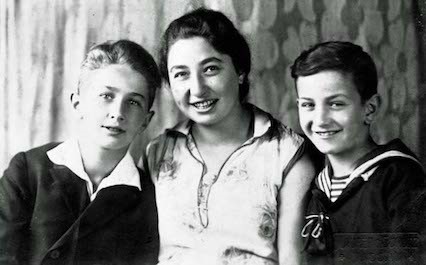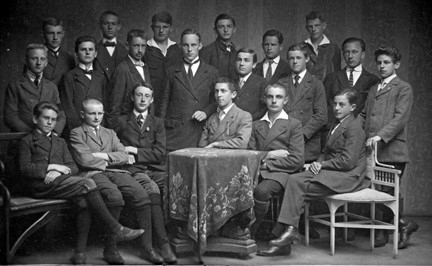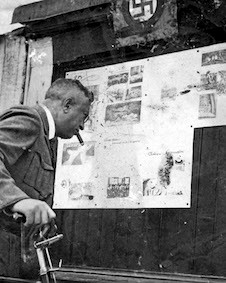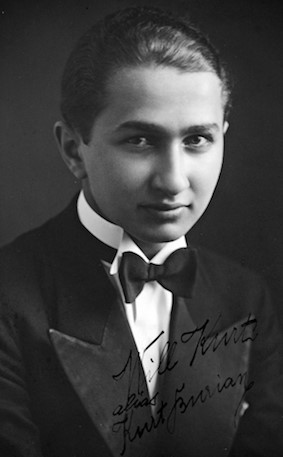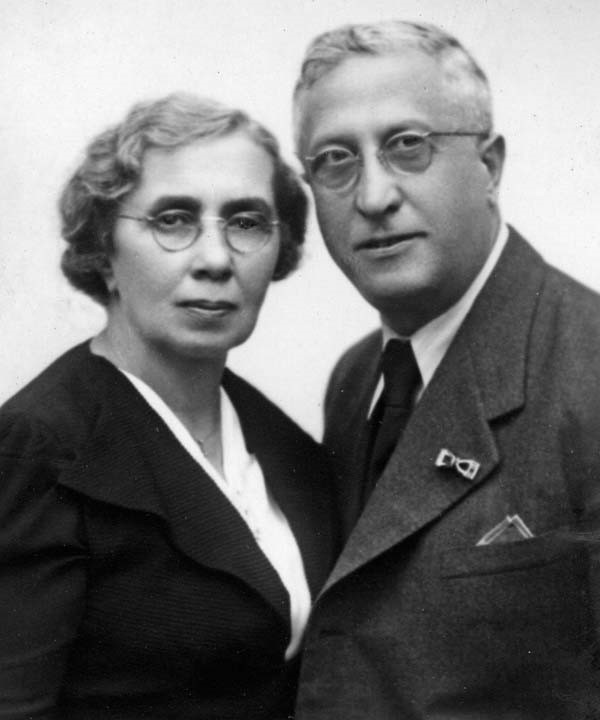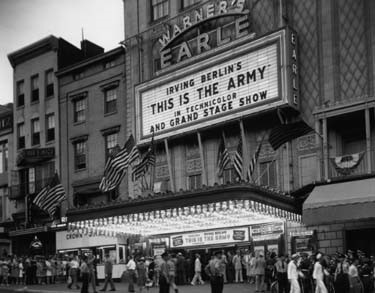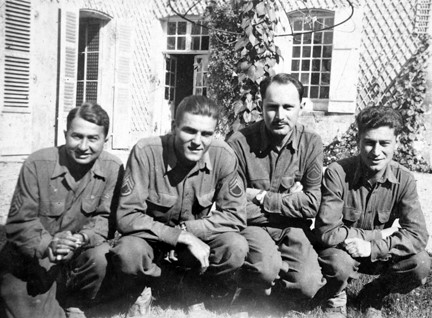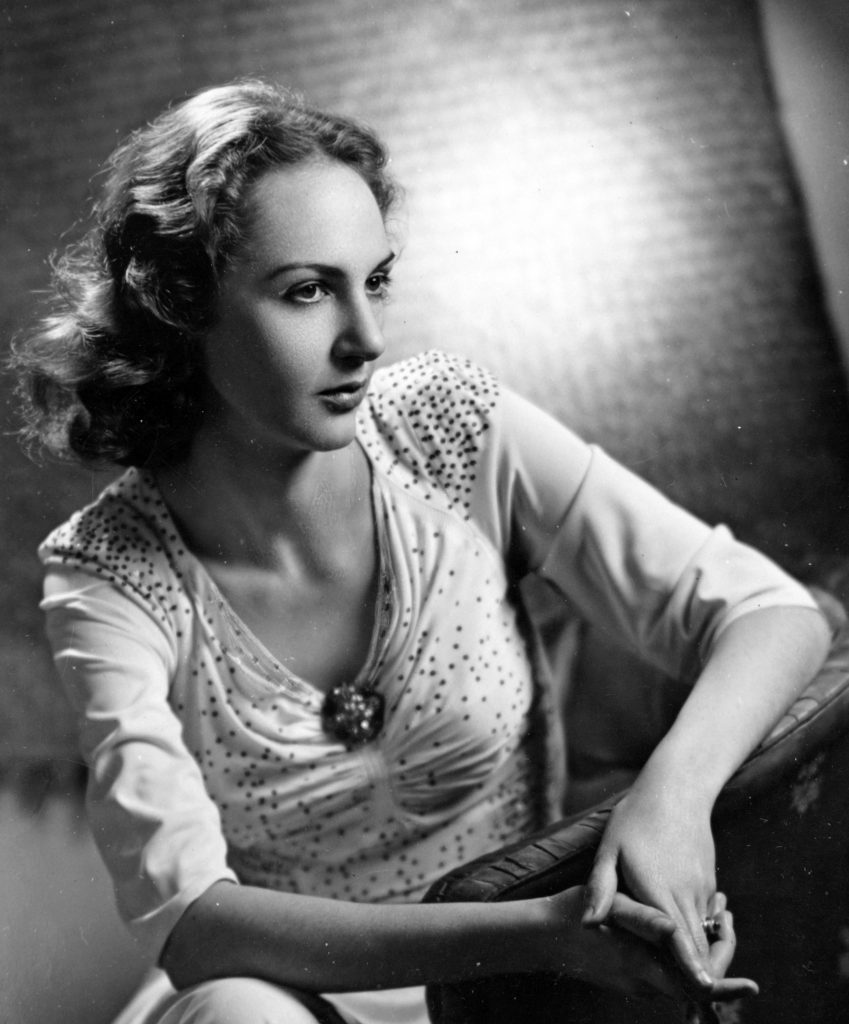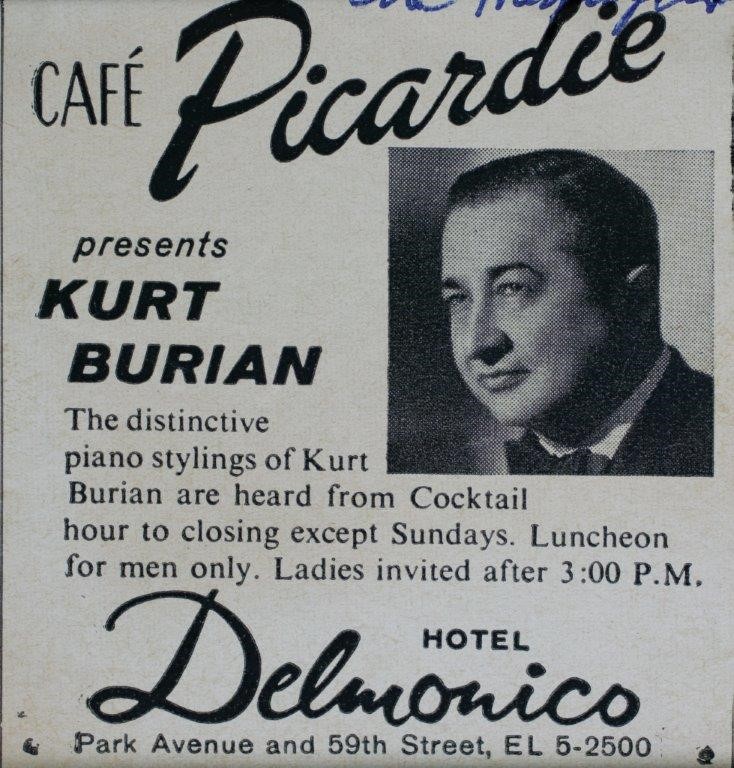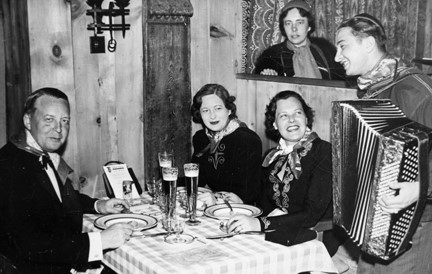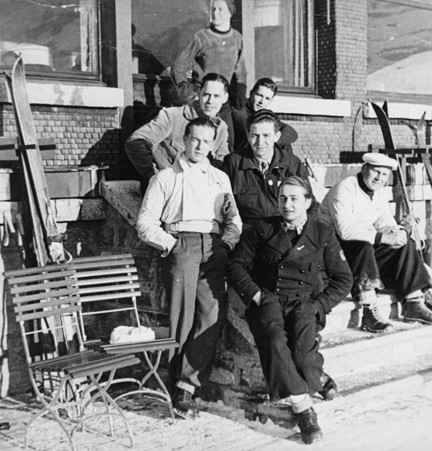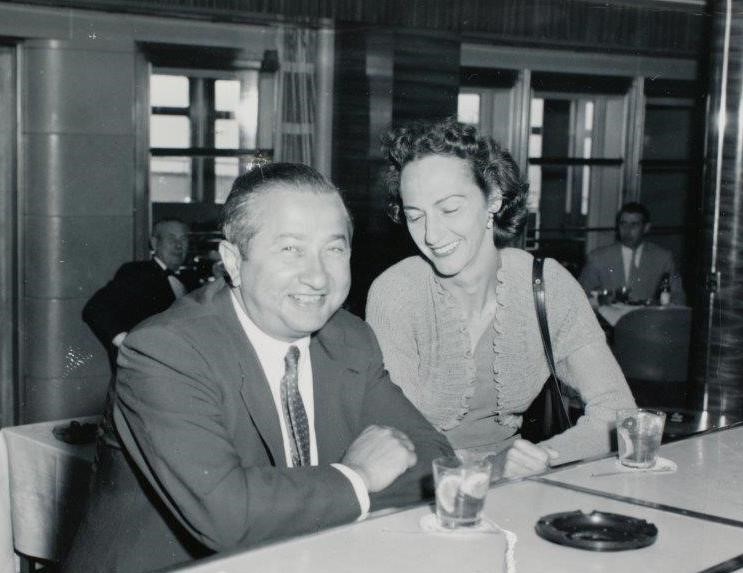Jan 2019
From Passau to Broadway — Kurt Burian and His Roots
von Anna Rosmus
Born in 1877 in the Vienna district of Hernals, Emil Burian was a certified window decorator and salesman. After he moved to Passau, he married Anna Kathinka Lippmann, a wealthy banker’s daughter from Würzburg. Before long, Emil became a German citizen. On July 21, 1908, Karolina Gertrude was born. Kurt was born on December 6, 1913, and Otto Heinrich on September 28, 1918.
Sue Townsend, Otto’s daughter and a retired teacher, states:
“I think this photo defines the three very well. Kurt is the sensitive, artsy, blond with the intelligent eyes. Trudl is the big sister trying somewhat unsuccessfully to keep the two in check, Otto, ever the mischief-maker with wheels turning, thinking of the next thing he might get away with.
It’s that imp in the little boys that the war took away. Every once in a while that little boy escaped from the desperate man, and it’s those moments I treasure the most.”
The Burian family lived in a large house, overlooking the Danube River, and the center of the ancient city, where they owned a fabric store. Otto remembered:
“My father was a great music lover. He owned a grand Berdux piano, a Schuster violin, and a large library with all classical composers, opera librettos and music literature with numerous bibliographies.”
Like other local children, the Burians attended St. Nikola public school until they were 10 years old.[1]
Afterwards, they attended a secondary school preparing them for the university by emphasizing modern languages and natural sciences.
Attending Passau Oberrealschule
In spite of significant anti-Jewish activities in the city,[2] the school year 1924/1925 at Oberrealschule was relatively bearable for Jews. As was the case throughout the area, most students were Catholic. Unlike other secondary schools, however, Oberrealschule had a somewhat liberal reputation, and a more diverse student body.
On June 15, 1924, the young Hans Werthmann[3] replaced music master Wilhelm Pöll, who used to teach voice and violin.
Kurt Burian attended Class 2. Among his classmates were 11 protestants.
Class 5a had 38 students. Among them were 12 protestants, Werner Deidesheimer, the son of a physician with Jewish roots,[4] Anton Hofmann, a future bishop of Passau, and his best buddy, Jewish Ilse Grünebaum[5].
Dr. Edwin Werner,[6] who taught new languages, led Class 6a. There, ten protestants and the sons of three merchants stood out. Julius Altmann from Vilshofen was Jewish, Azmi Guneim was a Muslim from Jerusalem, and Greek-Catholic Wladimir Rall from nearby Hals was born in Moscow, Russia.
In Class 7a Gertrud Burian met three protestants, Karl Pöllmann, the son of a retired Oberstleutnant, and Herbert Salisco,[7] the son of a retired local teacher.
The school year 1929/1930 started with 33 students in Class 1a, and it ended with 28 students. 13 were Protestants. Otto Burian was the only Jew. Wilhelm Pöll,[8] son of the previous music teacher, attended Class 1b.
Kurt Burian was now in Class 7a, which started with 30 students. Four were Protestants.
A vigorous nationalism had reached the classroom. Essay topics included the following homework assignments: “German loyalty in song and tales of the Middle Age”, “Guilt and atonement of Kriemhild in Hebbel’s Nibelungs”, and “The Relationships of Germany to the Eastern States of Europe”. Among the tests were the following questions: “The intellectual content of the singers saying ‘Where Danube, Inn and Ilz united kiss, a German song flows from a German heart”, “Gunther’s courting of Brunhild on Isenland. (According to Hebbel’s Nibelungs)”, “In what respect is the foreplay ‘The cuckolded Siegfried’ fundamental for Hebbel’s Nibelungs”, “In what respect does mostly the fate of Kriemhild destine the course of the drama in Hebbel’s Nibelungs?” and “What do I owe to the homeland?”
Despite their tender age, all three Burian siblings starred in school concerts.
By the end of 1929, however, after waves of anti-Jewish boycotts, and two lawsuits against the infamous Stürmer magazine, the Burian business had to be closed. Gertrude, one of the first female students of the local college, relocated to Berlin, where Ilse Grünebaum, her best friend, already lived. Kurt and Otto had to leave Oberrealschule.
Both boys moved to Munich with their parents. They lived in a five-room apartment on the fourth floor of Tengstrasse 6, in Schwabing, one of the most fashionable areas of the city. Emil Burian worked now as an exclusive sales representative, using his luxurious Graham Paige to service his territory.
He still could afford to pay for a higher education of his sons. While all siblings were musically talented, Getrude and Otto described their brother Kurt not only as the most gifted, but also “as a student in body and soul”, who became very proficient on the piano. Otto recalled him attending the prestigious Richard-Strauss-Conservatory, to become a professional musician.
By 1934, however, anti-Jewish restrictions increased further, and the income of their parents shrank. When the Jewish firm that Emil represented, went bankrupt, he lost his employment. At the same time, Otto pointed out that the college also denied his brother further enrollment “on racial grounds”.
After this decree, Kurt left Germany.
“My uncle Oskar,[9] the youngest brother of my father, who were all born in Vienna, was also a very well versed musician who had studied at the conservatory, and worked in Arosa, in Switzerland, as an entertainer. Due to immigration limitations, he and my uncle could not remain in Switzerland forever, [however].[10]
In the summer of [19]36, they went to Milan, and worked in two of the best hotels as musicians. But as Italy also began to become anti-Semitic, Kurt went to Panama. He had to pay the authorities there as much as he earned, and that was quite considerable”.
Lexikon der Juden in der Musik, a Germany state-sponsored encyclopedia from 1940, listed Kurt’s professions as “entertainment artist, pianist, violinist and singer”. Milan, Munich, Panama, and Passau were named as locations of his work.
Emigration to the USA
Sponsored by three people, who were not related to him, Otto Burian left Munich in April of 1938, via Antwerp. Upon arrival in New York City, he began to work as an assistant auto mechanic.[11]
Although he frankly admitted, “Kurt and I never had much in common. He played the big brother whom I rejected”, Otto did understand his dire need for emigration, pointing out that, “in 1939, I met some influential people[12] in New York who had granted Kurt the necessary affidavit to immigrate.”
US immigration records show him as a passenger of the ship Santa Paula. Cristóbal in the Canal Zone of Panama is listed as “Port of Departure”. Kurt arrived in New York on October 24, 1939, where Otto was listed as his friend. Kurt was 25 years old.
Once there, Kurt managed to remain a musician.
The 16th US Census, taken on April 18, 1940, shows Kurt Burian as a 26-year old white, male lodger on Manhattan’s West 95th Street. The house number was 177. His profession was listed as a “pianist”, who “private[ly]” had worked 30 hours during the last week in March.
In 1942, Kurt Burian became a citizen.
By now, Jews in Bavaria had not only been humiliated, deprived, robbed, driven away, tortured or killed, but even seemingly decent relationships between Jews and non-Jews had gone cold.
Failed Attempts to Save the Parents
Although physically safe, the thoughts of Kurt and Otto Burian frantically returned to their increasingly hapless parents in Munich. Arthur recalled:
“On April 1, 1938 my father had to completely relinquish his position as sales rep. who earned provisions. … At that time my brother, Kurt, was already sending money to my parents so they could live at all. And although my income at that time was very small, I have also sent them money.”
Arthur remembered that due to further hostilities against Jews, “My brother had rented an apartment for my parents in Milan at that time.” Their furniture was already packed in a large container. The registration card of the police stated: “De-registered on August 31, 1938 for Milan”. On September 1, 1938, however, both parents were once again registered in Munich, now living with Sulzbacher on Steinheilstrasse 20. Arthur explained,
My parents have not left the country, after Mussolini followed full blast the anti-Semitic ideas of the Third Reich on September 1, 1938,[13] and my brother informed my parents at the last moment to remain.
My brother has transferred $900 to an agent in New York in order to secure two illegal emigration visas for Cuba. At that time I had given my brother my complete savings to gather the $900.
On October 23, 1941 an order of Heinrich Himmler formally ended any possibility for Jews to leave the Greater German Reich. During the anti-Jewish pogroms most of the Burian furnishing was destroyed. A short time later, the couple had to give up their fancy Schwabing apartment and occupy very modest, small rooms in Reichenbachstrasse, and later in Zweibrückenstrasse 6, both in the less expensive borough, Isarvorstadt.
On November 15, 1941 Emil and Anna Kathinka Burian were deported to Riga.[14] The rest of their household goods, including new purchases, were confiscated and auctioned off.[15]
Joining the US Army
After President Roosevelt declared war on Japan, songwriter Irving Berlin proposed to boost morale with soldiers performing Yip! Yip! Yaphank on Broadway. Approved by General George Marshall in Washington, Berlin now called it This is the Army. He chose mostly professional entertainers, and although US armed forces were segregated at that time, Berlin did include black performers.
On January 5, 1942 Kurt Burian enlisted as a Private in Camp Upton Yaphank[16] “for the duration of the War or other emergency, plus six months, subject to the discretion of the President or otherwise according to law”. According to the U.S. World War II Army Enlistment Records, 1938-1946, he was still single without dependents. His height was listed as 64 inches, his weight 134 pounds.
In the spring of 1942, when rehearsals began at Camp Upton, New York, Berlin and stage director Ezra Stone commuted there.
Opening night was on July 4th. The musical was an instant hit. Planned for four weeks on Broadway only, Warner Brothers purchased the movie rights, and the army sent the show on a national tour. Eleanor Roosevelt arranged for her husband to see it in Washington D.C. By the time the tour ended in San Francisco in February 1943, it had already garnered the first $2 million for the Army Emergency Relief Fund.[17]
At age 80, Burian’s nephew, Fred Plotke, still recalls traveling by train from Chicago to Manhattan with his mother to see the musical. “Kurt was not an actor,” he describes. “He was in the orchestra pit, playing piano. His name was listed in the program.”
In October 1943, the performing company sailed to Liverpool. After London, they entertained Manchester, Birmingham, Glasgow and Belfast. After performing for General Eisenhower in London on February 6, 1944, he proposed that they play for soldiers on all fronts.
On March 1st, the company arrived in Algiers, to perform in North Africa. Next came Naples, Italy, and the Cairo Opera House. Most of September and October the troops spent in Iran. When Berlin joined the company in New Guinea at the end of the year, 15,000 GIs were in the audience.
Nearly three years after Kurt Burian and others had reported for temporary duty on This Is the Army, orders came for the Pacific. Cast and crew reached Guam on August 2, 1945, four days before the Enola Gay left that island to drop the first atomic bomb.
At that time, Kurt Burian served in the Intelligence Corps and was a technician third class . After he recommended his brother as a linguist, Private Otto Burian was assigned to Eisenhower’s SHAEF where he worked for G-2, an intelligence unit.
Returning to Civilian Life
After WWII, Kurt returned to the United States. He played at The Penthouse Club.
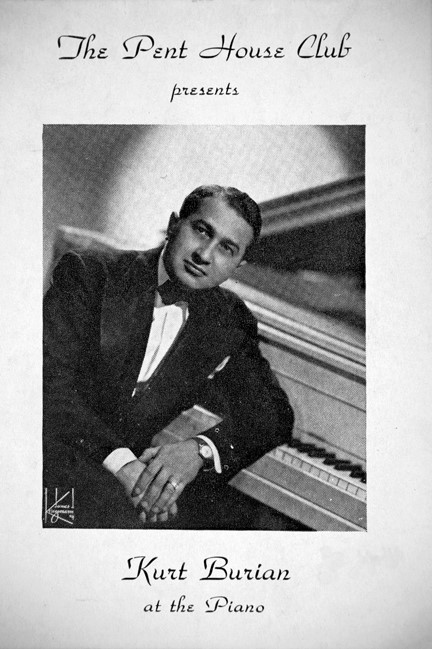
On March 1947, The Blackstone Hotel at 50 East 58th Street, featured the “smooth pianist” playing at its Dogwood Room.
Marriage
Before long, Kurt fell in love with Frances Thomas. Fred Plotke recalls her coming from a well-off family in the Detroit area.[18] “Frances worked as a Time/Life copy editor. Every time before a new edition was published, she worked 48 hour shifts.”
Arthur Burian reminisced:
“My sister-in-law studied music at the University of Louisiana, and majored in voice. She met my brother in a very exclusive café, where she first admired his musical talent.”
On April 24, 1947 the couple obtained marriage license no. 12073 from Manhattan. The newly-weds moved into the Peter Cooper Project. Their telephone exchange was ‘Murray Hill’.
Arthur Burian summarized that “the[ir] marriage was very good, and my brother enjoyed the years.”
When the Delmonico Hotel[19] on Park Avenue and East 59th Street opened its Cafe Picardy, invitations featured “Kurt Burian at the piano from seven-thirty until one nightly (except Sunday)”.
The NY Daily News from October 22, 1960 announced on p. 134, Kurt “holding down the keyboard at the Cafe Picardie.”
Kurt’s niece, Sue Townsend, reminisces:
“Ed Sullivan hosted a popular tv variety show. Kurt played piano at either the lounge of the Ed Sullivan Building or at a lounge in the building where Ed Sullivan lived.
I spent a week with Kurt and Frances when I was 15 or 16 years old. I loved the way she floated through a room! Keeping a slender figure, she was never far from a small jar of facial cream, and applied it regularly and often. In my eyes, she had an ethereal quality.
They owned TWO grand pianos in a small, 1-bedroom apartment and loved to play together. Unfortunately, the building was not soundproof and neighbors complained. Imagine that …. It must have been lovely to have live music in the building.
Anyone who visited, including Fred (and once me) slept on a sleeper sofa in the living room. I remember two or three small sketches of children, probably by a known artist, that were hanging to the left of the door. They were both very sophisticated, urban people, but the sketches belied a softer side, and were charming among their eclectic collection of furnishings.
[Like Emil and Anna Kathinka Burian], both retained a balance of culture and politics, I believe, perhaps leaving tidbits at various cultural societies.”
Missing Germany
Only few Jews have returned to Bavaria, attempting to regain their footing in a society that had ejected them. Gradually, Kurt Burian became one of them.
Fred Plotke vividly recalls visiting Kurt and Frances at Lake Constance in 1964.
Arthur described,
“My brother missed Germany very much. He was a liberal, extremely well-mannered individual, a first-rate gentleman. German culture was deeply rooted in him, and he never became a real American. He was very cosmopolitan, and spoke five languages almost fluently. He and his wife traveled the world, including the Orient. They collected memorabilia of many nations.”
Sue Townsend added, that “before visiting a country, it was not unusual for both Kurt and Frances to study the language so the travelers could more fully engage with people and enjoy the customs.”
“Later in life,” Fred Plotke tells, “Kurt arranged very high-end tours for the Murray Hill Travel Service on 9 East 38th Street. In 1966, a headline of its newsletter introduced “our indefatigable ship’s reporter and nautical buff, Kurt Burian”. What followed was a full page report about the couple’s trip “most exhilarating, varied and unforgettable trip to the Middle East” and Italy. A photo showed Frances and Kurt on horseback in Petra, Jordan.
The 1967 spring edition announced new conditions for groups traveling to Europe for two or three weeks. Fred Plotke remembers Kurt buying concert tickets to Salzburg…, and accompanying mostly wealthy widows to Germany and Austria.
Whereas Arthur admitted to “miss the mountains and the Bavarian coziness, which I learned to love in Munich. I lived there for ten years”, Kurt not only “traveled extensively in Germany after the War”, but on December 14, 1970, he and his wife moved there. Although John Townsend met his great-aunt Frances only once, probably in late 1970, he does recall her last address from memory: 21 Höhenbergstasse in Feldafing, at Lake Starnberg.
Although Frances did own a home in Detroit in 1971, after both of her parents had passed away,[20] Germany became their sole domicile. Sue Townsend wrote: “It was my understanding that Kurt and Frances left the US after McGovern lost his bid for the 1972 Presidency.”
Death in the Dolomites
The US Social Security Index death record merely lists “September 1972” as time of Kurt’s passing. The Passau city registrar, however, lists Februar 15, 1978 in Bruneck, Italy.
Arthur explained that his brother “died during a ski vacation in the Italian Dolomites. There was no autopsy, so we do not know the cause of death.” Arthur’s daughter adds, however, “It is my understanding that Kurt died of a heart attack.”
When Frances passed away on March 10, 1999, she was single.
In Memoriam
For Arthur Burian, who later in life became a Certified Financial Planner, music was his refuge. Sue Townsend recalls:
“Dad could extrapolate and create both melody and a complicated accompaniment all of his own design and style. He rarely played classical music, which was Kurt’s forte, even though Kurt also played typical easy listening and dance music professionally. Sometimes I would hear my Dad come home after a music job. It was in the early morning hours. We’d go to the den, where the piano was located and the two of us would ‘jam’, he on the piano and I on the clarinet. As long as I played clarinet and did not play anything serious on the piano, we shared music as a common language, and could and would play for hours without a sheet of music in sight.”
Accompanied by his sister Gertrude and his nephew Fred, Arthur visited Passau in 1988. A few months later, he suffered a massive heart attack. Sue Townsend writes:
“I am sure that Dad died of a broken heart, and would suppose that Kurt might have also. However, Kurt had what he claimed he wanted, a German homeland, European lifestyle, mountains, active life (skiing), Frances by his side, travel paid for by his travel business.”
On March 12, 2010, Richard Schaffner, the Passau city archivist, e-mailed that he purchased a local estate that included 20 photographs pertinent to Kurt Burian. In 2015, the Passau Stadtjugendring had a memorial marker placed where the Burian family used to live.
Notes
[1] Otto/Arthur recalled in the late 1980s, to have been “raised as a 100% assimilated German with Jewish background, and did not recognize the least differences other than the fact that the priests at the Nikola School could not [forcefully] enroll me in the religious instructions.”
[2] Following Heinrich Himmler’s return to Passau on February 14, 1925 for example, Jewish stores were boycotted again. (For details see: Anna Rosmus, 75 Jahre Reichskristallnacht, Simone Samples, Grafenau 2013, p. 29.)
[3] For details about this teacher see: Anna Rosmus, Hitlers Nibelungen, Samples Grafenau, 2015, pp. 131, 132, 189.
[4] For details about this family see: Anna Rosmus, Exodus. Im Schatten der Gnade, Dorfmeister Tittling, 1988, pp. 24-27; Anna Rosmus, 75 Jahre Reichskristallnacht, Samples Grafenau, 2013, pp. 30, 126, 130, 131; Anna Rosmus, Hitlers Nibelungen, pp. 59, 211;
[5] For details about Ilse Grünebaum see: Anna Rosmus, Exodus. Im Schatten der Gnade, Dorfmeister Tittling, 1988, pp. 85-117; Anna Rosmus, Against the Stream, University of South Carolina Press, Columbia SC 2002, pp. 91-93; Anna Rosmus, 75 Jahre Reichskristallnacht, Samples Grafenau, 2013, pp. 15, 21, 29, 87;
[6] For details about this teacher see: Anna Rosmus, Hitlers Nibelungen, pp. 54, 62;
[7] After World War II, at a Spruchkammer, Salisco helped to render judgments about former National Socialists: Anna Rosmus, Hitlers Nibelungen, pp. 54, 62.
[8] For details about this teacher see: Anna Rosmus, Hitlers Nibelungen, pp. 141, 172, 173, 203, 226, 262, 275.
[9] Sue Townsend recalls Oskar playing for the Vienna Philharmonic after WWII.
[10] The 16th US Census, taken on April 18, 1940, listed his residence on April 1935 as “St. Moritz, Switzerland”.
[11] In 1944, when Otto became an American citizen, he anglicised his two first names to Arthur Henry.
[12] One was Frank Vass. He and his wife, Violet, a kind-hearted and humorous couple who unequivocally loved Otto, remained friends with him until they died.
[13] Benito Mussolini had ordered Jews who entered Italy since January 1, 1919 to leave within six months. This affected some 10,000 people. The Chicago Daily Tribune reported on September 2, 1938 on page 1, “Expel All Jews Who Moved to Italy Since ’19”.
[14] In 1961, a Munich court determined the date of death as December 31, 1945. Reparations, however, were not completed until July of 1962. After Kurt Burian decided that he wanted none of that money, his portion was divided among his siblings’ children.
[15] For details about the Burian family see: Anna Rosmus, Exodus. Im Schatten der Gnade, pp. 145-174.
[16] When stationed at Camp Upton during WWI, Irving Berlin had written the musical, which included the song “Oh! How I Hate to Get Up in the Morning.” When this musical became the movie This Is The Army in 1943, it starred Lt. Ronald Reagan.
[17] In the end, Jack Warner donated $9,555,586.44 to the Army Emergency Relief Fund.
[18] Born on November 23, 1913 in Johnstown, Cambria County, PA, Frances M. was the daughter of mechanic Frank August Bremer and his wife, Loretta Mary Stibich. The US Census from 1920 lists both of Frank’s parents as German-speaking. The young family lived as lodgers in the 13th District of Detroit, Wayne County, MI. Daughter Patricia Maryanne was born there in 1922. The Census from 1930 lists Frank’s parents as Germans from Westphalia. At that time, Frank was a die setter in an automobile factory. His house in Ward 15 was valued at $12.500. The family shared it with Clemens and Albert, two adult nephews from Pennsylvania. In 1934, the Detroit city directory lists Frances M. Bremer and her parents at the same address. According to the US census of 1940, Frank August had earned $800 in 1939.
[19] In August 1964, when the Beatles stayed there, the hotel became a center of Beatlemania.
[20] Their last residence was located in Cedarville, Mackinac County, MI. The father passed away on September 12, 1960, the mother on August 24, 1961. Patricia Maryanne Bremer died on October 21, 1990 in San Diego, CA. (Source: family tree of 3,800 people on Ancestry.com by Michael Stebick, a retired lawyer from Orchard Park, NY.)

